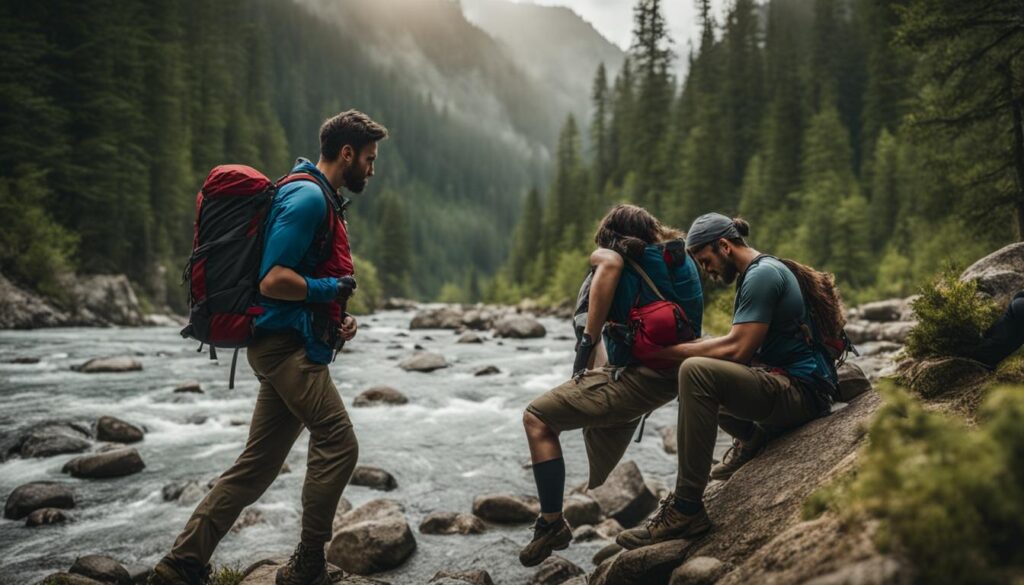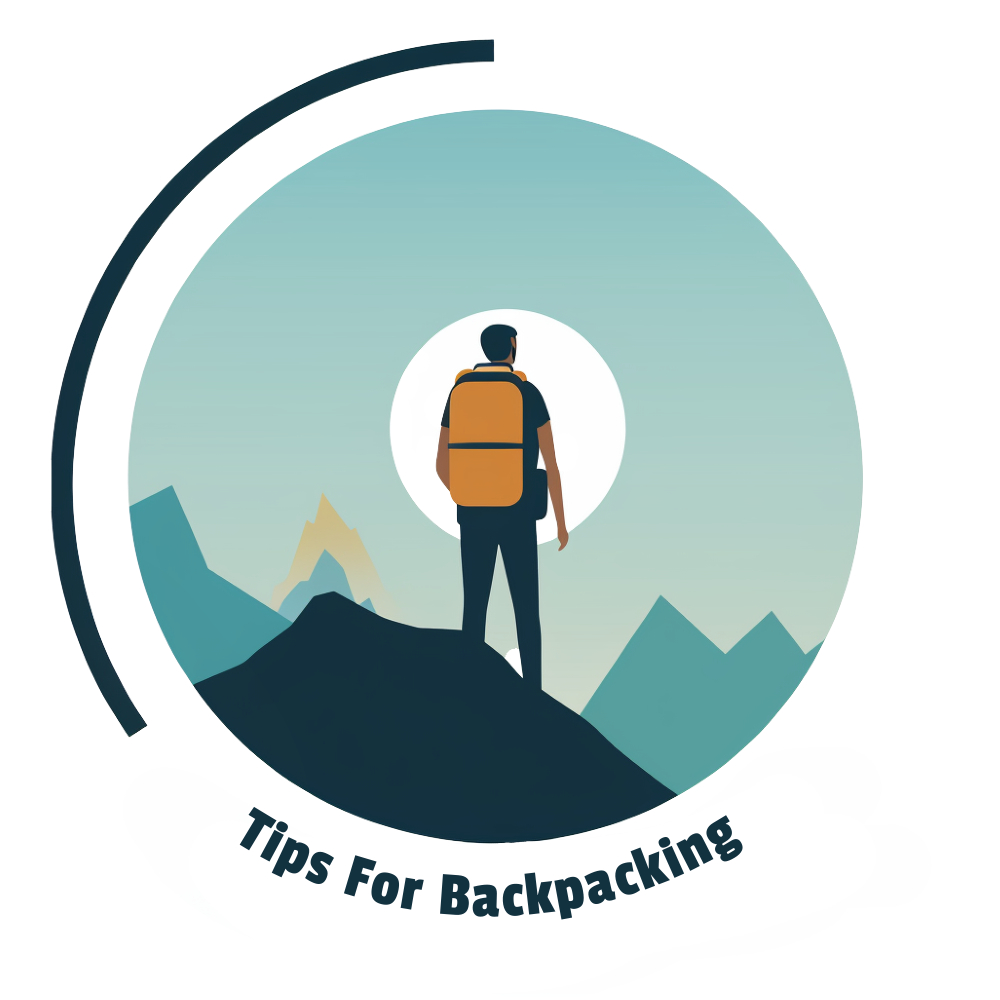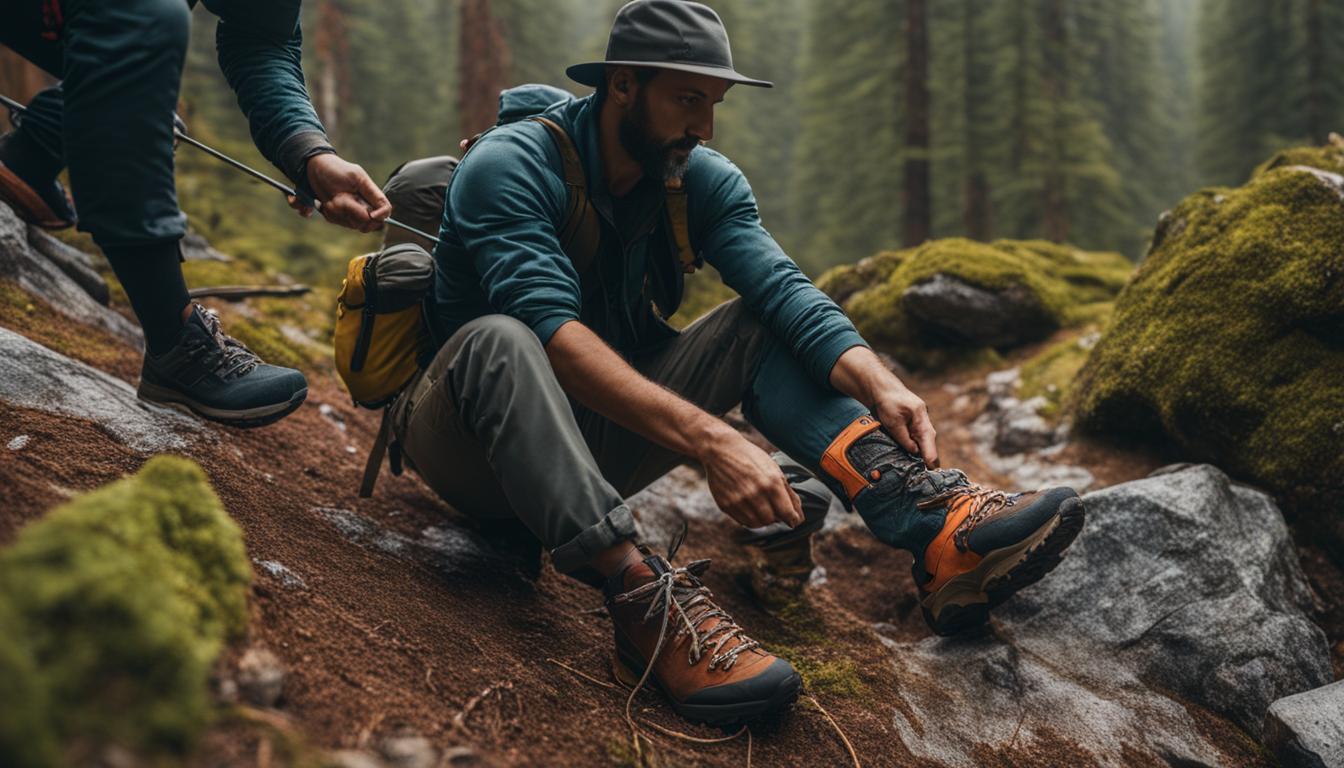Wilderness first aid is an essential skill for anyone venturing into the outdoors. In a wilderness setting, emergency responders and urgent care clinics are often far away, making it crucial to be self-sufficient in handling emergencies.
The first step in wilderness first aid is to evaluate the patient by assessing the scene, identifying life threats, conducting a focused exam, making a care plan, and providing medical and emotional support. Taking a wilderness first-aid class and having a reference book for medical issues are recommended. It’s important to understand that safety is the individual’s responsibility, and proper techniques and safety requirements should be practiced before rendering first aid. Wilderness first aid differs from traditional first aid in terms of time, environment, resources, and communication.
Key Takeaways:
- Wilderness first aid is crucial for outdoor enthusiasts due to the distance from emergency responders.
- Assessing the scene and identifying life threats are important steps in wilderness first aid.
- Taking a wilderness first-aid class and having a reference book can enhance preparedness.
- Safety is the individual’s responsibility, and proper techniques and safety requirements should be practiced.
- Wilderness first aid requires adaptation to the unique challenges of the outdoors.
Preparing to Give Wilderness First Aid

Before providing wilderness first aid, it is crucial to evaluate the scene for safety and identify any potential dangers. This initial assessment sets the foundation for effective treatment. When evaluating the scene, I consider several factors such as the mechanism of injury and form a general impression of the seriousness of the situation. This helps me understand the extent of the injury or illness and prioritize the required actions.
Identifying the number of patients is another important step in preparing to give wilderness first aid. This allows me to assess the resources needed and plan accordingly. Additionally, protecting myself is essential to ensure my own safety while providing aid. I always wear gloves and a mask when approaching patients to minimize the risk of infection.
Once the scene has been evaluated and potential dangers have been identified, I obtain consent to treat from the patient. Establishing responsiveness and conducting an initial life-threat exam are also crucial steps. This exam includes checking the patient’s airway, breathing, circulation, and disability to determine the immediate risks and take appropriate actions. By following these preparatory steps, I can provide effective wilderness first aid and ensure the safety and well-being of the patient.
Quote:
“Evaluating the scene and protecting oneself are vital steps before providing wilderness first aid. By assessing potential dangers and taking necessary precautions, we can ensure the safety of both the patient and the first responder.” – Wilderness Medic Journal
Table: Common Injuries and Mechanism of Injury
| Injury | Mechanism of Injury |
|---|---|
| Fractured Bone | Impact or excessive force to the affected area |
| Heat Exhaustion | Dehydration and prolonged exposure to extreme heat |
| Severe Bleeding | Laceration or puncture wound |
| Anaphylactic Shock | Allergic reaction to an insect bite or food |
| Head Injury | Blow to the head or sudden impact |
Wilderness first aid: Initial and secondary patient assessment
Once the scene has been assessed for safety and potential dangers, the first step in providing wilderness first aid is to obtain consent to treat and establish the patient’s responsiveness. This initial assessment is crucial for determining the immediate life threats and addressing them accordingly. The ABCDE exam is a systematic approach used in wilderness first aid to evaluate the patient’s airway, breathing, circulation, disability, and exposure to injury. By prioritizing these aspects, we can ensure the patient receives the most appropriate care.
With the initial life threats addressed, a secondary patient assessment is conducted to gather more information about the patient’s condition. This assessment includes a head-to-toe examination to identify any additional injuries or signs of illness. Checking vital signs such as the level of responsiveness, heart rate, respiration rate, and skin signs provides valuable insights into the patient’s overall health. Additionally, gathering the patient’s history helps in creating a comprehensive treatment plan that meets their specific needs.
At this stage, it’s crucial to document the vital information obtained during the assessment. This includes details of the patient’s injuries, vital signs, and any other relevant observations. By documenting this information, we can track the patient’s progress over time and ensure continuity of care. With a complete understanding of the patient’s condition, we can make informed decisions about further treatment, evacuation if necessary, and provide appropriate care in the wilderness.
Table: Vital Signs Assessment
| Vital Sign | Normal Range | Assessment |
|---|---|---|
| Level of Responsiveness | Awake and alert | Assess patient’s cognitive function and ability to follow commands. |
| Heart Rate | 60-100 beats per minute | Measure patient’s pulse and assess for irregularities. |
| Respiration Rate | 12-20 breaths per minute | Count patient’s breaths and assess for any abnormalities. |
| Skin Signs | Pink, warm, and dry | Check patient’s skin color, temperature, and moisture level. |
By conducting a thorough initial and secondary patient assessment, wilderness first aid providers can gather the necessary information to make informed decisions about further treatment and care. This assessment helps in identifying immediate life threats, evaluating vital signs, and understanding the patient’s overall condition. Armed with this knowledge, we can create a treatment plan that addresses the patient’s specific needs and provide the best possible care in the wilderness.
Wilderness first aid: Treating common medical issues and making an evacuation
When it comes to wilderness first aid, being prepared to handle various medical issues is crucial. Whether you’re facing hiking injuries, bleeding control, infection prevention, or treating burns, having a solid treatment plan is essential.
Firstly, proper wound care is essential in the wilderness. Clean the wound thoroughly, apply an appropriate dressing, and don’t forget to monitor for any signs of infection. Remember, prevention is key, so pack some antiseptic wipes in your first aid kit.
Additionally, knowing how to approach shock is crucial. Keep the patient warm, elevate their legs if possible, and monitor their vital signs closely. Shock can be life-threatening, so it’s crucial to act fast.
Lastly, overcoming hypothermia is a top priority in outdoor emergencies. Remove wet clothing, wrap the patient in a warm blanket, and provide heat through warm fluids or a heat source if available. Remember, these are just initial steps, and seeking professional medical help or evacuation may be necessary in more severe cases.
What First Aid Techniques Can Be Applied in Dealing with Wildlife Encounters in the Outdoors?
When managing backyard wildlife challenges in the outdoors, it’s important to know first aid techniques for wildlife encounters. If bitten or scratched, wash the wound thoroughly and seek medical help. Do not approach the animal and keep a safe distance. Most importantly, stay calm and contact wildlife professionals for assistance.
FAQ
What is wilderness first aid and why is it important?
Wilderness first aid is a crucial skill for anyone venturing into the outdoors. It involves learning how to handle emergencies in wilderness settings where professional help may be far away. It’s important to be self-sufficient in handling emergencies and providing medical care until help arrives.
How do I prepare to give wilderness first aid?
Before providing wilderness first aid, it is important to assess the scene for safety and identify any potential dangers. It involves evaluating the mechanism of injury, forming a general impression of the seriousness of the situation, and protecting yourself by wearing gloves and a mask. Obtaining consent, establishing responsiveness, and conducting an initial life-threat exam are key steps in preparing to give wilderness first aid.
What is involved in the patient assessment for wilderness first aid?
The patient assessment for wilderness first aid starts with obtaining consent and establishing responsiveness. It involves a systematic approach known as the ABCDE exam, which evaluates the airway, breathing, circulation, disability, and exposes injuries. After addressing the initial life threats, a secondary patient assessment is conducted to gather more information through a head-to-toe exam, checking vital signs, and gathering patient history.
What medical issues can be treated with wilderness first aid?
Wilderness first aid encompasses treating various medical issues that may arise in outdoor environments. These include spine and head injuries, shock, wounds and infections, burns, bone and soft-tissue injuries, heat-related illnesses, altitude illness, lightning-related injuries, allergic reactions, and chest pain or altered mental status.
When is evacuation necessary in wilderness first aid?
Evacuation may be necessary in wilderness first aid for severe injuries or worsening conditions. If a patient’s condition is deteriorating or if the injury or illness requires advanced medical care that cannot be provided in the wilderness, evacuation is necessary to get the patient to a proper medical facility.
What should I pack in a wilderness first aid kit?
It is important to have a well-stocked first aid kit when venturing into the wilderness. Essentials include bandages, antiseptic wipes, adhesive tape, pain relievers, tweezers, sterile gauze, a CPR mask, and any personal medication that may be required. It’s always a good idea to consult a wilderness first aid guide or take a wilderness first aid class to understand the necessary items for your specific outdoor activities.

